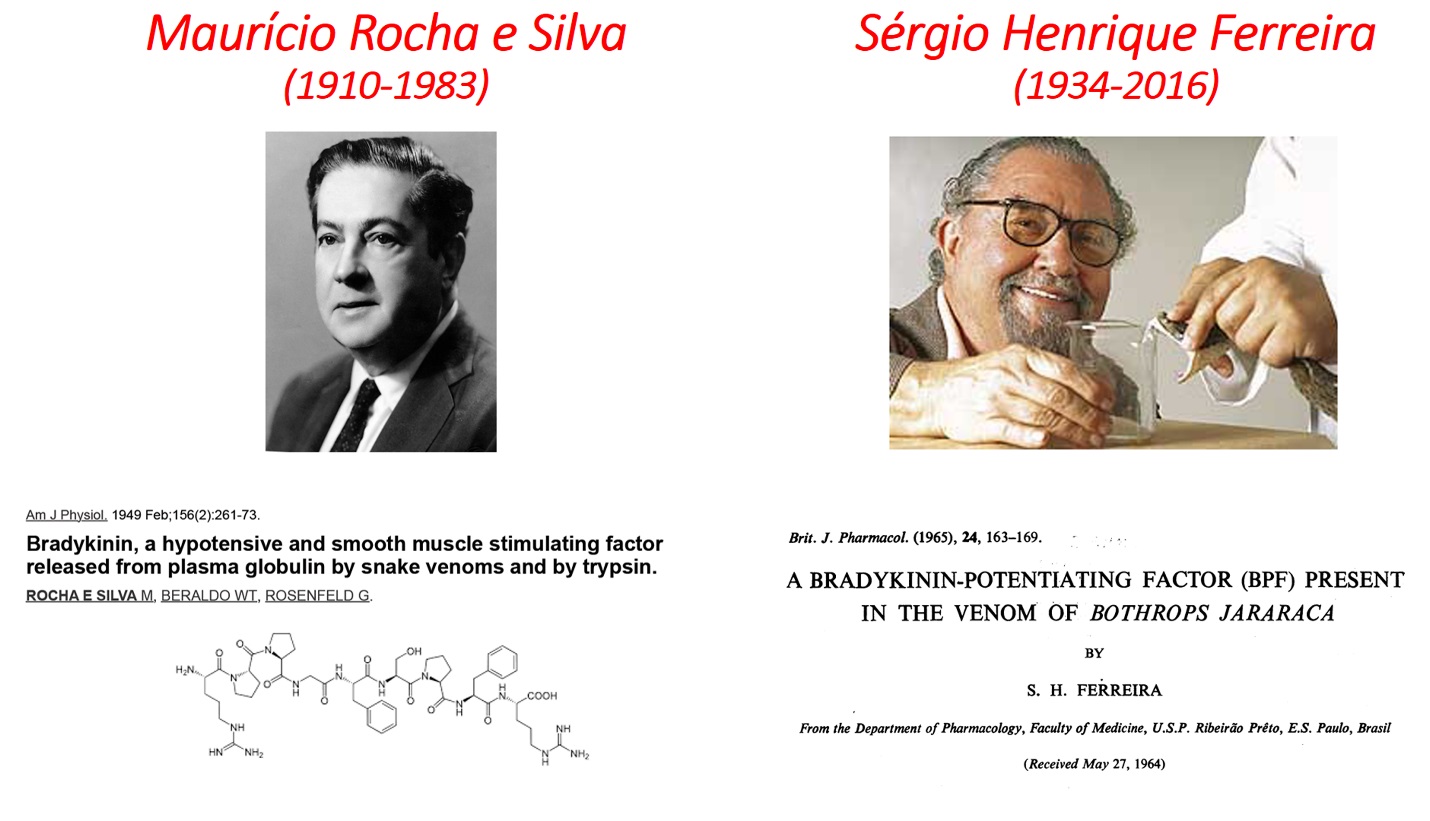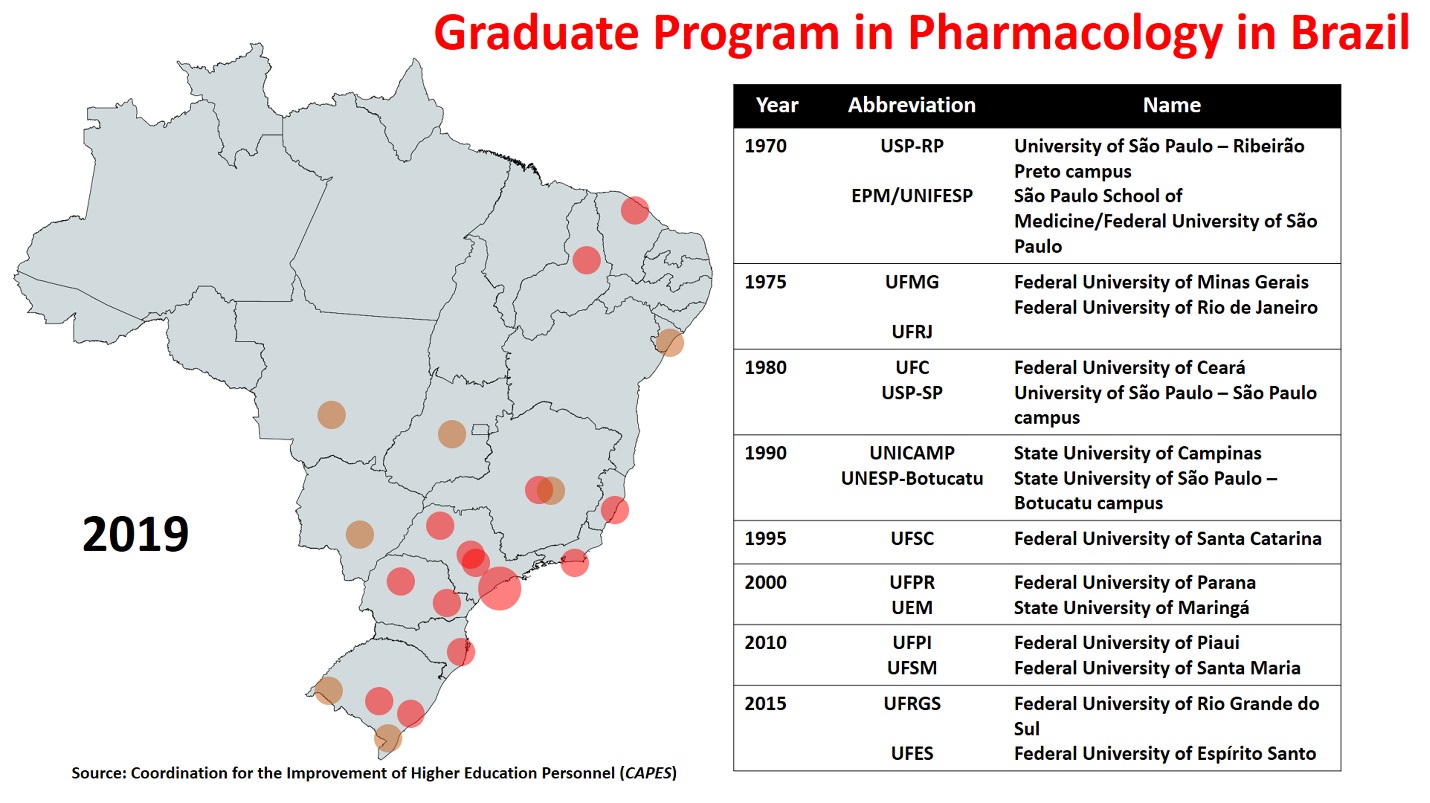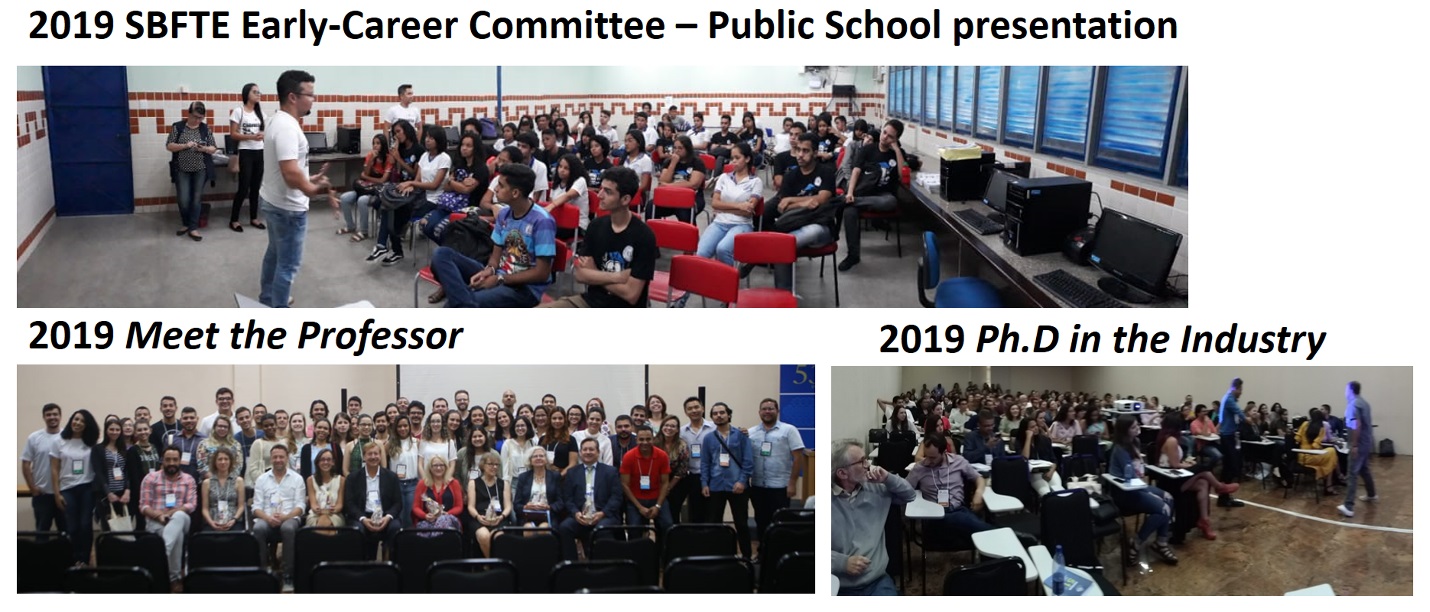The recent history of pharmacology in Brazil
The medicinal potential of the biodiversity in Brazil was known several centuries before the ‘discovery’ of our land by the Portuguese conquerors. Native Brazilians had long treated illness with extracts from nature. The migration of Africans during the slavery period of colonialism added more knowledge in the use of natural resources. Brazil occupies most of the eastern part of the South American continent and its geographic heartland covers approximately 48% of South America. It has the world's most extensive river systems, with eight major drainage basins, all of which drain into the Atlantic Ocean. The variety of climates, soils, and drainage conditions in Brazil is reflected in the biodiversity of our fauna and flora, which are rich in natural compounds. Much of the climate is tropical, although the south is relatively temperate, which provides opportunities for discovering molecules with bioactive potentials. It seems that only the tip of the iceberg has been uncovered in the potential of Brazil for discovering new drugs.

The ‘discovery’ of Brazilian lands. (Left) The encounter between the Portuguese conquers and the native Brazilians in 1500 was portrayed in oil by Oscar Pereira da Silva, 'Landing of Pedro Alvares Cabral in Porto Seguro', available to visit at the Museu Paulista, Sao Paulo. (Right) The use of ointments and natural products by native Brazilians was portrayed in the painting 'Os Índios' (The native Brazilians) by Jean Baptist Debret during an artistic French excursion in the 18th century.
The medicinal use of plants began to be documented in the 19th century, when ‘formal’ biomedical science was established in Brazil. This was largely due to the immigration of a number of internationally recognized scientists, who were dedicated to building research and educational centres in Brazil. Their cooperation laid the foundation for productive pharmacology as an essential discipline for biomedical sciences in Brazil and was pivotal in the creation of world-renowned centres. These centres include the Instituto Butantan, the largest immunobiological and biopharmaceutical producer in Latin America (and one of the largest in the world) and the Oswaldo Cruz Foundation, one of the world’s major public health institutions dedicated to the research and development of biological therapeutics.
Cooperative research between Brazilian and international pharmacologists was established in the mid-20th century. The Second International Pharmacological Meeting, held in Prague in 1963, officially integrated Brazil as a developing country devoted to pharmacological research. Professor Mauricio Rocha e Silva, a talented, renowned pharmacologist born in Brazil, and one of the first generation to be trained by this cooperation program, attended this conference. He laid the foundation for Brazil to host the Third International Pharmacological Meeting in Sao Paulo in 1966, where over 1000 researchers from 15 countries attended the congress. Shortly after the meeting, the Brazilian Society of Pharmacology and Experimental Therapeutics (SBFTE) was founded as a non-profit organisation and led by Professor Rocha e Silva as president from 1966 to 1981. Nowadays, most Brazilian pharmacologists are linked to at least five generations of researchers who were trained by or collaborated with Professor Rocha e Silva. His discovery of bradykinin in the venom of Bothrops jararaca, a native Brazilian snake, and the discovery of the bradykinin-potentiating factor by Professor Sergio Henrique Ferreira (also a former president of SBFTE), were fundamental for the development of pharmacology in Brazil and worldwide (Figure 2).
 Pioneer Brazilian-born pharmacologist Professor Mauricio Rocha e Silva discovered bradykinin in 1948 after isolation in the venom of Bothrops jararaca, a native Brazilian venomous snake. Professor Sergio H Ferreira, a former PhD student of Professor Rocha e Silva, discovered the bradykinin-potentiating factor.
Pioneer Brazilian-born pharmacologist Professor Mauricio Rocha e Silva discovered bradykinin in 1948 after isolation in the venom of Bothrops jararaca, a native Brazilian venomous snake. Professor Sergio H Ferreira, a former PhD student of Professor Rocha e Silva, discovered the bradykinin-potentiating factor.
At that time, strong collaborative ties between Brazilian and foreign scientists allowed the establishment of graduate programmes around the country, and the number of these programmes is still rising. Centres of pharmacological research were created within universities such as the University of Sao Paulo, São Paulo School of Medicine, Federal University of Minas Gerais, Federal University of Rio de Janeiro, Federal University of Ceara, State University of Campinas, State University of São Paulo, Federal University of Santa Catarina, among others (Figure 3). These were instrumental in training generations of talented, Brazilian-born pharmacologists.

Graduate and research programs dedicated to pharmacology in Brazil. The first graduate program dedicated to the training of pharmacologists was created at the University of Sao Paulo (campus Ribeirão Preto) and São Paulo School of Medicine in the 1970s. Nowadays, a total of 15 graduate programs in pharmacology are sponsored by the Coordination for the Improvement of Higher Education Personnel (CAPES, acronym in Portuguese), indicated by the red circles. Also, there are an increasing number of graduate programs in biological or biomedical sciences with research lines in the field of pharmacology (orange circles).
The Early Career Investigators Committee
The SBFTE is now one of the largest pharmacology-related societies in Latin America in terms of number of affiliates, and its members include some of the leading scientists in pharmacology in Latin America. In 2013, the society created the Early Career Investigators Committee (SBFTE Jovem, in Portuguese), which aims ‘to create a permanent political–scientific discussion forum dedicated to undergraduate, graduate students, young investigators and junior faculty members of SBFTE to discuss scientific topics related to Pharmacology, helping in the development of their careers, as well as their participation, insertion and collaboration into the activities of SBFTE. The first assembly of this Committee occurred during the SBFTE’s 45th Annual Congress, held in Ribeirão Preto, São Paulo.
For the last 4 years, I have been in the leadership of this Committee, together with other enthusiastic young pharmacologists on the Board. Our major activities are educational initiatives in public high schools in the cities hosting the SBFTE Annual Congress, which include awareness of rational use of medicines, among others, and the distribution of comic books of pharmacology, which provides information in a proper language to teenagers. So far, this initiative distributed more than 5K comic books written by Brazilian scientists funded by universities such as UFRJ and UFSC, and supported by SBFTE and federal funds (such as the INCT-INOFAR, CAPES, FINEP). During the SBFTE’s Annual Congress, we also invite the top scientists attending the Congress to a get-together round table with the early-career members of our Society for discussions on how to build an efficient and successful career at a Meet the Professor session. Also, ‘PhD in the industry’ session explores new possibilities in formal training in positions outside the academia by discussing entrepreneurship, innovation, and partnership with the private sector. These sessions are now top-ranked in the Congress and annually has the participation of at least a quarter of the attendees (Figure 4). Our Committee has agreed with the Commission Board of the Society for increasing the number of the talks in the sessions of the Congress, including oral communications, lectures and round table discussions, to be presented by early-career investigators. It is noteworthy to mention that our expertise and successful model have been shared with other scientific societies in Brazil and countries in Latin America and Europe.

Early Career Investigators Committee activities during the 2019 51st Congress of the Brazilian Society of Pharmacology and Experimental Therapeutics. In 2019, activities in the public schools reached 200 students of high schools and 200 students that visited the Conference center hosting the Annual Congress. The Meet the Professor session hosted 62 attendees and 8 top worldwide scientists for discussions about career development (down-left picture). The PhD in the Industry session had 148 attendees. This year the discussion was centered on the challenges of changing career, the importance of cooperation between academia and industry and how to improve the communication and awareness of science.
What the future holds
By learning the recent history of pharmacology in Brazil, we can prospect for the future. In adverse scenarios, as are now occurring after political and economic cuts in science funding, creativity raises opportunities for collaboration, which are growing within graduate programs all over the country. Looking to the future of pharmacology in Brazil, it is encouraging the growth of the creativity and resilience of the early career members of our scientific community. These are certainly two of the most recognized features of the Brazilian people. Maybe, because the people of Brazil are passionate, this explains their devotion to science and their courage in keeping up quality and the production of good data.
Importantly, by providing educational initiatives, increasing social and cultural equality, networking and relevant information for the current generation of early-career members, we may accelerate this catching-up process. As a young scientist devoted to good science, honored to the generations of talented pharmacologists that provided the base of pharmacology in Brazil, and an active member of pharmacological societies, I believe that we can unite generations of scientists and continue to advance pharmacological development. To do so, we must continue to foster opportunities and to encourage early-career members, as they are the future generation of pharmacologists in Brazil and worldwide.
Comments
If you are a British Pharmacological Society member, please
sign in to post comments.